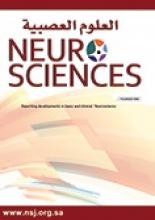Research ArticleOriginal Articles
Open Access
Decreased serum uric acid in patients with traumatic brain injury or after cerebral tumor surgery
Miao He, Jianqiao Zheng, Hao Liu, Ying Wu, Xinsheng Xue, Chaoran Wu and Huiping Li
Neurosciences Journal January 2021, 26 (1) 36-44; DOI: https://doi.org/10.17712/nsj.2021.1.20200089
Miao He
From the Department of Anesthesiology (He, Zheng, Wu), Department of Neurosurgery (Liu), Department of Neurology (Wu), Department of Critical Care Medicine (Xue), West China Hospital of Sichuan University, Sichuan, China
MDJianqiao Zheng
From the Department of Anesthesiology (He, Zheng, Wu), Department of Neurosurgery (Liu), Department of Neurology (Wu), Department of Critical Care Medicine (Xue), West China Hospital of Sichuan University, Sichuan, China
MD, PhDHao Liu
From the Department of Anesthesiology (He, Zheng, Wu), Department of Neurosurgery (Liu), Department of Neurology (Wu), Department of Critical Care Medicine (Xue), West China Hospital of Sichuan University, Sichuan, China
MD, PhDYing Wu
From the Department of Anesthesiology (He, Zheng, Wu), Department of Neurosurgery (Liu), Department of Neurology (Wu), Department of Critical Care Medicine (Xue), West China Hospital of Sichuan University, Sichuan, China
MD, PhDXinsheng Xue
From the Department of Anesthesiology (He, Zheng, Wu), Department of Neurosurgery (Liu), Department of Neurology (Wu), Department of Critical Care Medicine (Xue), West China Hospital of Sichuan University, Sichuan, China
MD, PhDChaoran Wu
From the Department of Anesthesiology (He, Zheng, Wu), Department of Neurosurgery (Liu), Department of Neurology (Wu), Department of Critical Care Medicine (Xue), West China Hospital of Sichuan University, Sichuan, China
MD, PhDHuiping Li
From the Department of Anesthesiology (He, Zheng, Wu), Department of Neurosurgery (Liu), Department of Neurology (Wu), Department of Critical Care Medicine (Xue), West China Hospital of Sichuan University, Sichuan, China
MD, PhD
References
- ↵
- Kanbay M,
- Jensen T,
- Solak Y,
- Le M,
- Roncal-Jimenez C,
- Rivard C,
- et al.
- ↵
- ↵
- Tana C,
- Ticinesi A,
- Prati B,
- Nouvenne A,
- Meschi T
- ↵
- Driggin E,
- Helmke S,
- De Los Santos J,
- Teruya S,
- Guadalupe S,
- Goldsmith J,
- et al.
- ↵
- Chamorro A,
- Dirnagl U,
- Urra X,
- Planas AM
- ↵
- Vila E,
- Sole M,
- Masip N,
- Puertas-Umbert L,
- Amaro S,
- Dantas AP,
- et al.
- ↵
- Llull L,
- Renu A,
- Laredo C,
- Codas J,
- Rudilosso S,
- Urra X,
- et al.
- ↵
- Hatefi M,
- Dastjerdi MM,
- Ghiasi B,
- Rahmani A
- ↵
- Adiga US,
- Vickneshwaran V,
- Sen SK,
- Thiagaragan G
- ↵
- ↵
- Martinez-Moral MP,
- Kannan K
- ↵
- Keenan RT
- ↵
- Caliceti C,
- Calabria D,
- Roda A,
- Cicero AFG
- Virdis A,
- Masi S,
- Casiglia E,
- Tikhonoff V,
- Cicero AFG,
- Ungar A,
- et al.
- ↵
- Li JJ,
- Huang YH,
- Lin YY,
- Li MM,
- Chen YF,
- Cai RW
- ↵
- Spiga R,
- Marini MA,
- Mancuso E,
- Di Fatta C,
- Fuoco A,
- Perticone F,
- et al.
- ↵
- ↵
- Di Pietro V,
- Yakoub KM,
- Caruso G,
- Lazzarino G,
- Signoretti S,
- Barbey AK,
- et al.
- ↵
- Mironczuk-Chodakowska I,
- Witkowska AM,
- Zujko ME
- ↵
- Lu HY,
- Ning XY,
- Chen YQ,
- Han SJ,
- Chi P,
- Zhu SN,
- et al.
- ↵
- Gaipov A,
- Solak Y,
- Turkmen K,
- Toker A,
- Baysal AN,
- Cicekler H,
- et al.
- ↵
- Aliena-Valero A,
- Lopez-Morales MA,
- Burguete M,
- Castello-Ruiz M,
- Jover-Mengual T,
- Hervas D,
- et al.
- ↵
- Cutler RG,
- Camandola S,
- Feldman NH,
- Yoon JS,
- Haran JB,
- Arguelles S,
- et al.
- ↵
- Liu H,
- He J,
- Zhong J,
- Zhang H,
- Zhang Z,
- Liu L,
- et al.
- ↵
- Iida S,
- Yamamoto Y,
- Susa C,
- Tsukui K,
- Fujisawa A
- Lida S,
- Ohkubo Y,
- Yamamoto Y,
- Fujisawa A
- Kozlik P,
- Hasikova L,
- Stiburkova B,
- Zavada J,
- Kalikova K
- ↵
- Esiaba I,
- Angeles DM,
- Holden MS,
- Tan JBC,
- Asmerom Y,
- Gollin G,
- et al.
- ↵
- Julius D
- Mandal AK,
- Mount DB
- ↵
- Tong BB,
- Jutzeler CR,
- Cragg JJ,
- Grassner L,
- Schwab JM,
- Casha S,
- et al.
- ↵
- Cicero AF,
- Rosticci M,
- Bove M,
- Fogacci F,
- Giovannini M,
- Urso R,
- et al.
- ↵
- De Giorgi A,
- Fabbian F,
- Pala M,
- Tiseo R,
- Parisi C,
- Misurati E,
- et al.
- ↵
- Amaro S,
- Renu A,
- Laredo C,
- Castellanos M,
- Arenillas JF,
- Llull L,
- et al.
- ↵
- Thyrion L,
- Raedt R,
- Portelli J,
- Van Loo P,
- Wadman WJ,
- Glorieux G,
- et al.
In this issue
Decreased serum uric acid in patients with traumatic brain injury or after cerebral tumor surgery
Miao He, Jianqiao Zheng, Hao Liu, Ying Wu, Xinsheng Xue, Chaoran Wu, Huiping Li
Neurosciences Journal Jan 2021, 26 (1) 36-44; DOI: 10.17712/nsj.2021.1.20200089
Jump to section
Related Articles
- No related articles found.
Cited By...
- No citing articles found.





